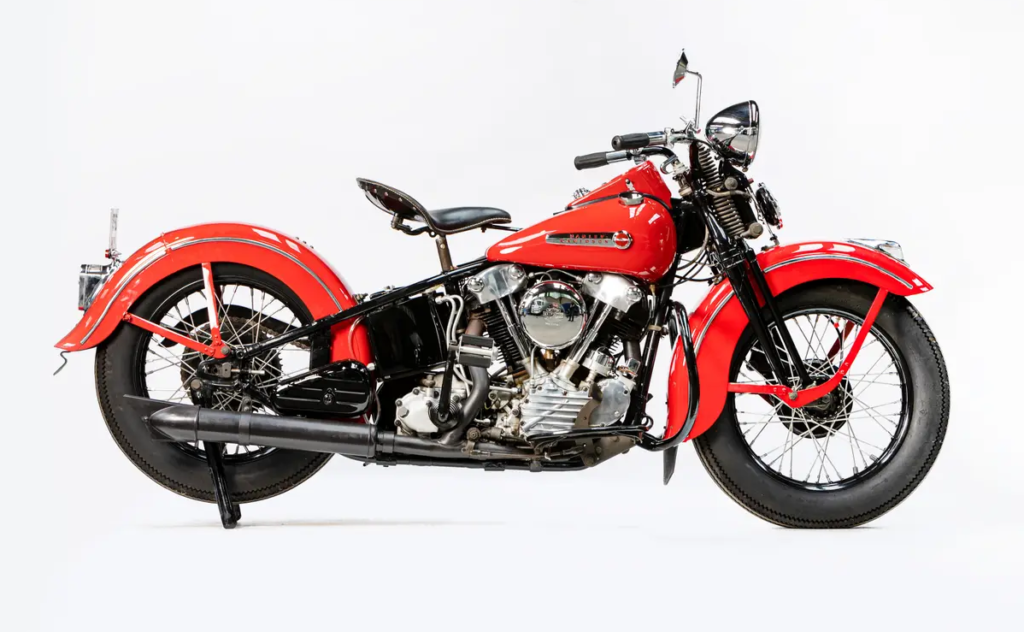
How the Harley Davidson Knucklehead Engine Changed Motorcycles
In 1936, Harley Davidson roared onto the scene with a machine that wasn’t just a motorcycle, it was a revolution: the Knucklehead. This Harley engine, named for its distinctive valve covers that resembled clenched fists, wasn’t just a pretty face. It was a technological leap that forever changed the landscape of motorcycling.
Before the Knucklehead engine, Harley Davidson ruled the road with the trusty Flathead engine. These side-valve beasts were reliable, but slow and prone to overheating. Enter the Knucklehead engine, a 61 cubic inch overhead-valve monster. This new design boasted improved airflow, better heat management, and a near-doubling of horsepower. Suddenly, Harley riders weren’t just cruising, they were flying.
The impact was immediate. Motorcycles were no longer just utilitarian workhorses; they became symbols of freedom and speed. The Knucklehead’s power and performance appealed to a new generation of riders, hungry for thrills and adventure. Choppers, bobbers, and hot rods sprung up around the Knucklehead, creating a vibrant custom motorcycle culture that thrives to this day.
But the Knucklehead’s influence wasn’t just about speed. It was about engineering. Its innovative overhead-valve design laid the groundwork for all future Harley engines, right up to the Milwaukee-Eight rumbling through streets today. The Knucklehead’s reliability and ease of maintenance made it a favorite among mechanics and DIY enthusiasts, fostering a deep connection between riders and their machines.
Of course, the Knucklehead wasn’t perfect. Early models suffered from teething problems, and its thirst for oil was legendary. But these quirks only added to its mystique. Owning a Knucklehead wasn’t just about riding, it was about belonging to a brotherhood of wrench-wielding gearheads, united by their love for this temperamental beast.
The Knucklehead’s reign at the top ended in 1948, replaced by the smoother, more refined Panhead. But its legacy lived on. The Knucklehead became a prized collector’s item, fetching sky-high prices and inspiring countless custom builds. It remains a symbol of Harley Davidson’s golden age, a testament to their willingness to push boundaries and build machines that not only got you there, but got you there with a fistful of adrenaline.
So next time you hear the rumble of a Harley, remember the Knucklehead. It’s the engine that punched motorcycles into a new gear, and its influence continues to echo through every twist of the throttle, every custom build, and every fist raised in the wind.
The Complexities of the Harley-Davidson Knucklehead Engine
The Harley-Davidson Knucklehead wasn’t just a pretty face with its distinctive valve covers resembling clenched fists. Beneath that chrome exterior resided a revolution in engine design, an overhead-valve masterpiece that redefined the landscape of motorcycling. Let’s delve into the intricate mechanics of this legendary engine, exploring the challenges it presented and how it paved the way for future advancements.
Breaking Free from the Sidelines: The Overhead-Valve Advantage
Before the Knucklehead, Harley-Davidson, like most motorcycle manufacturers, relied on side-valve engines. These workhorses were reliable but lacked the oomph needed for exhilarating rides. The Knucklehead changed the game with its overhead-valve design. Here’s how it worked:
Overhead Camshaft: Unlike side-valve engines where the camshaft sits beside the cylinders, the Knucklehead placed it atop the cylinder head. This allowed for more precise timing of the valve opening and closing, leading to better combustion and increased power output.
Pushrods and Rocker Arms: The camshaft interacted with the valves via pushrods and rocker arms. This intricate dance ensured efficient valve operation, maximizing airflow and fuel intake.
Improved Airflow and Combustion: The overhead-valve design allowed for straighter intake and exhaust ports, promoting smoother airflow and more efficient combustion. This translated to a near-doubling of horsepower compared to the Flathead engine, propelling riders into a new era of speed and adrenaline.
Challenges and Quirks: Taming the Beast
While the Knucklehead’s overhead-valve design was groundbreaking, it wasn’t without its challenges. Here are some of the hurdles engineers faced:
Heat Management: The increased power output generated more heat, demanding a robust cooling system. Harley-Davidson addressed this with larger fins and improved oil circulation, but early models were still prone to overheating, especially in hot climates.
Valve Adjustment: Unlike side-valve engines where valve adjustments were relatively simple, the Knucklehead’s overhead configuration made it a more complex process. This required regular maintenance and mechanical know-how, adding to the mystique (and sometimes frustration) of owning a Knucklehead.
Oil Leaks: The engine’s intricate design, with its numerous gaskets and seals, was susceptible to oil leaks, further adding to the maintenance burden. However, for dedicated Knucklehead owners, these quirks became badges of honor, testaments to their mechanical prowess and unwavering love for their temperamental machines.
A Legacy of Innovation: Knucklehead Pave the Way for the Future
Despite its challenges, the Knucklehead’s impact on the motorcycle industry was undeniable. Here’s how it paved the way for future advancements:
Overhead-Valve Dominance: The Knucklehead’s success cemented the superiority of overhead-valve designs. This technology became the industry standard, influencing generations of motorcycle engines, from Harley-Davidson’s own Panhead to modern sportbikes and touring machines.
Performance Evolution: The Knucklehead’s power boost ignited a race for even higher performance. This led to continuous engine advancements, pushing the boundaries of horsepower, torque, and efficiency.
Custom Culture Catalyst: The Knucklehead’s unique character and challenges fueled a thriving custom motorcycle culture. Choppers, bobbers, and hot rods sprouted around this engine, showcasing the creativity and individuality of riders who embraced its quirks and turned them into statements of personal expression.
The Harley-Davidson Knucklehead wasn’t just an engine; it was a revolution. Its overhead-valve design, while presenting challenges, unleashed a new era of power, performance, and customization. The rumble of a Knucklehead still echoes through the decades, a testament to the ingenuity, passion, and rebellious spirit that continue to define the world of motorcycling. So, the next time you hear that unmistakable roar, remember, it’s not just the engine you’re hearing; it’s the song of a legend, the Knuckles of Chrome and Freedom, forever etched in the history of two-wheeled adventure.
